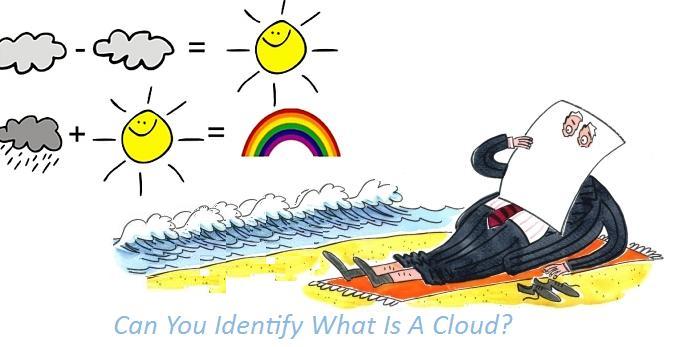Can You Identify What Is A Cloud?
 I have been following the technology market from a long time and much is said in use of the cloud, but whenever I come across IT managers and CIOs, they do not know the right way to differentiate the systems server virtualization and cloud computing. Let us understand the fundamental differences.
I have been following the technology market from a long time and much is said in use of the cloud, but whenever I come across IT managers and CIOs, they do not know the right way to differentiate the systems server virtualization and cloud computing. Let us understand the fundamental differences.
How Does It Work?
The cloud is a cluster of servers that are publicly accessible via the Internet. These servers are usually owned and managed from a provider or data center. The machines can run different operating systems. These computers work in parallel, combining the resources of each to generate computational capacity compared to that of supercomputers.
This cloud architecture is quite simple, although it requires a smart management to connect all computers and assign the processing of each task. The user request is passed to the management system, which provides the necessary resources.
The key to the concept of cloud computing is the automation of many management tasks. The system in which human intervention is required to allocate processes to resources is not a cloud, but a common system hosted in a datacenter-based and client / server model. To enable the system to achieve the status of cloud, all management tasks should be replaced by automation.
When purchasing a server in the cloud, the user gets a virtual server, which can work from anywhere in the world. The user has no way of knowing exactly where the server is running. Actually, user data can be stored on one or more of the computers used to create the cloud. As the cloud dynamically manages the available resources, the actual storage location can vary from day to day or even minute to minute, but regardless of your actual location, the user sees a “static” data and can manage its resources as if the server is connected on local network.
The cloud storage has financial benefits and associated security. Financially, the virtual resources in the cloud are usually cheaper than dedicated server’s physical resources. As regards safety, the data stored in the cloud is in an environment which is less prone to accidental deletion or hardware failure, since the data is maintained continuously, the cloud continues to function normally even if one or more machines are disconnected. If the machine fails, the data is accessed by other machines in the cloud without the user noticing that there was a failure in the physical structure.
Deployment Models
Private Cloud : The cloud infrastructure is used exclusively by one company. Can be managed by the company or provider’s infrastructure.
Public cloud : The cloud infrastructure is made available to the general public and is owned by a company, the provider that sells these services.
Hybrid Cloud : The cloud infrastructure is composed of one part and another part of public facilities, inside the same physical structure.
Essential Characteristics
So we can consider a service on the Internet as cloud service, that service must have five basic characteristics. They are:
Self-Service : The consumer has access at any time to provide processing power, memory and disk space, automatically, without the need for human interaction of the employees of the provider.
Broad Network Access : Resources should be available over the network and can be accessed by any device that has internet access, it may be fixed or mobile devices.
Reserved Resources : The resource provider must be available to meet different consumers’ needs that have different needs of resources to be distributed and redistributed according to need of customers. These resources include storage, processing, memory, bandwidth, and virtual machines.
Elasticity : The provider resources should be allocated quickly and should be released in the same way so that other consumers can take advantage of them. For the consumer, the capabilities of the provider must seem limitless to be purchased in the quantity and time they desire.
Measurement service : The cloud systems control and optimize the use of resources automatically. The use of these resources must be monitored and made available to consumers to have the clarity of what was used.
As shown, in order to understand a system like cloud computing, it must meet all specified requirements, otherwise we only have a virtualized system.
Briefly, I tried to clear up the most common conceptual doubts about whether the system that is being used is not a system but cloud computing.
If you are looking forward to utilize cloud solutions for your business, use “TRYENLIGHT” coupon code and get free access to cloud.
For More Information, Refer Our eNlight Cloud Computing Solutions Page.
- How Cloud Computing Is Changing The Labor Market - March 25, 2015
- Adopting Infrastructure as a Service Can be a Good Deal - March 17, 2015
- Will Virtualize? Take These Six Points Into Consideration - March 12, 2015
